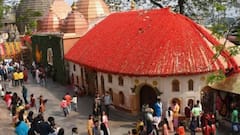Strife-Torn Manipur Finds Place Of Pride In Parliament As 'Kokyet' Named Official Headgear Of Staff Uniform
Besides the Manipuri “Kokyet,” other articles of the new uniforms include Nehru jackets of magenta or deep pink shade for the secretariat staff and camouflage for security officers.

Guwahati: For a change, trouble-torn Manipur had some reason to celebrate as its “Kokyet", or the Manipuri turban, has been chosen as part of the dress code for the Marshals of the Indian Parliament.
The Government of India is introducing new uniforms for both houses of Parliament — Lok Sabha and Rajya Sabha — for the upcoming five-day special session scheduled to begin on Monday. Besides the Manipuri 'Kokyet', the other parts of the new uniforms include Nehru jackets of magenta or deep pink shade for the secretariat staff and camouflage for security officers, a group of senior Manipur-based journalists stated in a press release on Thursday.
Manipuri culture exponent and former director of Manipur Art and Culture Department, K Sobita Devi, who has also authored a book titled, ‘The Traditional Dress of the Meiteis', expressed joy over Centre's move. She said, “The government has recognised the rich culture of the state. It is very interesting and we are hopeful that it will highlight the rich culture of Manipur to the rest of the world but at the same time, I just do not know exactly which Kokyet been chosen for the purpose as there are 12 different varieties of “Kokyets” and the same are used by different strata of the society during different occasions, from commoners to that of the royals.”
“The 'Kokyet' is the symbol of divine protective sign from time immemorial because it has been derived from the two horns of 'Lord Pakhangba' (supreme God), who has many facets, thus symbolising the whole of “Atiya Guru Sidaba” (king of Gods) as the protective symbol of the Meitei culture,” Sobita Devi said.
In Sobita Devi's book, it has been mentioned that the “Kokyet” developed the culture remarkably among the Meiteis. The use of “Kokyet” differed significantly in style and according to the purpose of use and occasion.
The history of “Kokyet” dates back to the reign of the Meitei mythical God-king “Nongda Lairen Pakhangba” in 33 AD as he used “Kokyet Pheiyet” (one of the varieties), and in later times, the Manipuri princess used it occasionally, the press release said.
Yumnam Bhubaneshor Singh, a Manipuri cultural artist has supervised the new design of the “Kokyet” to be worn by the Marshals in the Parliament.
According to Singh, the newly designed “Kokyet” have brand new colour patterns and design inspired by the “Salai Taret Kokyet” (seven colours representing the seven clans of the Meiteis) with “Lamthang Khulak” (a specially designed Manipuri handicraft).
Sharing his joy, celebrated theatre director Kshetri Jugindro said it is a matter of pride and honour for Manipur.
Jugindro, who is also the former secretary of Manipur State Kala Academy, said that there are certain varieties of “Kokyets” which are meant for specific occasions and echelons of the society. He hoped that the ones which are to be donned by the Parliament Marshals do not breach the cultural ethos of the state.
Secretary of Manipur State Film Development Society (MSFDS) Sunzu Bachaspatimaym has a different version but hailed the government for the move.
“I must say I have mixed emotions at the introduction of the “Kokyet” in the Parliament. While I am thrilled to know that our cultural heritage is being recognised and has duly found a space in the Parliament, I am sceptical as Meitei fabric heritage is steeped in hierarchy and symbolism that must be observed,” Bachaspatimaym said.
The special five-day session, commencing on September 18, is expected to mark a poignant farewell to the current Parliament building, which has witnessed historic moments throughout India's journey. On the first day, both Houses are likely to engage in discussions regarding the role and significance of the old Parliament building, both pre- and post-Independence. The subsequent day may see a symbolic joint meeting convened at the Central Hall, before proceedings transition to the splendid new edifice.







































